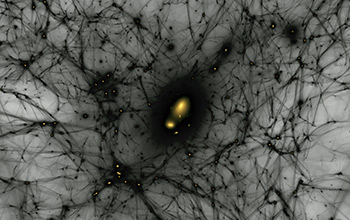Multimedia Gallery
Simulation of formation of dark matter structures from the early universe to today
Still image from simulation of the formation of dark matter structures from the early universe to today. Gravity makes dark matter clump into dense halos, indicated by bright patches, where galaxies form. In this simulation, a halo like the one that hosts the Milky Way forms and a smaller halo resembling the Large Magellanic Cloud falls toward it. SLAC and Stanford researchers, working with collaborators from the Dark Energy Survey, have used simulations like these to better understand the connection between dark matter and galaxy formation.
[Research supported by U.S. National Science Foundation grants AST 1517422, PHY 1748958 and DGE 1656518. In addition, this work was performed by the Dark Energy Survey, which is funded in part by NSF.]
Learn more in the Stanford University news story The Milky Way’s satellites help reveal link between dark matter halos and galaxy formation. (Date image taken: Dec. 2019; date originally posted to NSF Multimedia Gallery: July 30, 2020)
Credit: Ralf Kaehler/Ethan Nadler/SLAC National Accelerator Laboratory
Images and other media in the National Science Foundation Multimedia Gallery are available for use in print and electronic material by NSF employees, members of the media, university staff, teachers and the general public. All media in the gallery are intended for personal, educational and nonprofit/non-commercial use only.
Images credited to the National Science Foundation, a federal agency, are in the public domain. The images were created by employees of the United States Government as part of their official duties or prepared by contractors as "works for hire" for NSF. You may freely use NSF-credited images and, at your discretion, credit NSF with a "Courtesy: National Science Foundation" notation.
Additional information about general usage can be found in Conditions.
Also Available:
Download the high-resolution JPG version of the image. (2.4 MB)
Use your mouse to right-click (Mac users may need to Ctrl-click) the link above and choose the option that will save the file or target to your computer.

